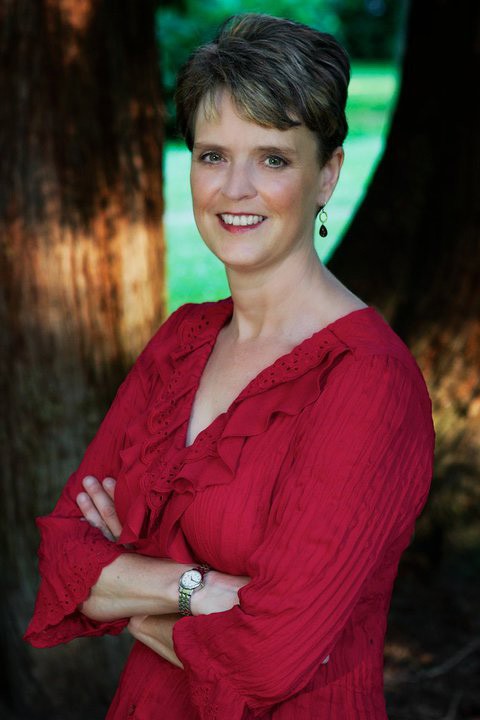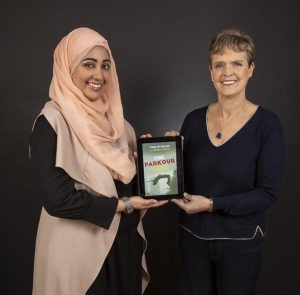
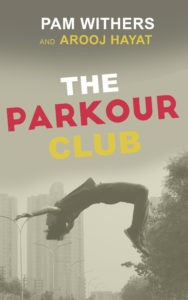
This podcast interview between Crystal Hunt of Strategic Authorpreneur and author Pam Withers was released July 28, 2020. The version below corrects typos in the version posted at https://strategicauthorpreneur.com/podcast/022-writing-collaboratively-with-pam-withers/
Crystal: So we are here with Pam Withers, who is a young-adult author of many thrilling and exciting titles. So, you write adventure books primarily, right Pam? I would love if you could tell our audience a little bit about what you write and how you came to be doing those kinds of books.
Pam Withers: Okay, so I have written 21 sports and outdoor adventure books for teens. And the reason that I have that niche is, that is how I mis-spent my youth. I was a whitewater kayaker and a whitewater kayak instructor. I married the Canadian coach and was a whitewater raft guide. I kayaked the Colorado River through the Grand Canyon. When my mother and father and older sister lived above the Arctic circle, my mother would travel by dogsled across the river to deliver babies — while expecting me. So I think I get my adventure genes legitimately.
Crystal: You come by it very honestly, yes. And you do a lot of interesting research, I would imagine. I’ve seen pictures of you ziplining over rainforests and doing all kinds of cool stuff over the years.
Pam Withers: That’s my favorite part of writing: the research. To make the writing authentic.
Crystal: And for this current book that we’re going to talk a little bit about today [The Parkour Club], you have a co-author.
Pam Withers: I do. I am very proud of my co-author, Arooj Hayat. The novel is The Parkour Club and it basically mixes adventure, sports and cross-cultural understanding. I couldn’t possibly write a book about cross-cultural understanding without working with somebody who was open-minded and fun and interested in achieving the same goals.
Crystal: And how did you two meet? How did you come to be working together?
Pam Withers: Before I even outlined my book, I knew I needed to work with someone, so I contacted the BC Muslim Society and asked if they could refer me to someone willing to work with me. Although they do this for journalists all the time, it took some guts on my part to make that request. They tapped Arooj because she was a youth leader for her mosque at that time. She and I met in a coffee shop and we just clicked immediately. We’re both extroverts. We are both giggly extroverts with a sense of humor. We both wanted to achieve what this book wanted to achieve (cross-cultural understanding). So we talked with each other to learn from each other. Right from the get-go, it was a perfect match. And I feel very lucky for that.
Crystal: Yeah. That’s like winning the dating lottery in the writing life.
Pam Withers: There you go.
Crystal: So what did the process of actually co-authoring look like for the two of you? Everyone I’ve ever talked to, who has co-written books, has done it in slightly different ways. So for you two, what did that mean?
Pam Withers: I had roughly outlined the book, so I needed to know she was okay with my rough outline, and then we basically had a three-stage process of collaboration.
First, I would interview her for a particular scene or aspect of the novel. Then I would write a rough draft, and then she would rewrite or edit it — or tell me I couldn’t use a certain word, or inform me that the Arabic word for something was such-and-such.
I want to give you an example. For instance, I had to write a scene where my Muslim character Pearl is getting a hard time in high school for wearing a hijab and for being Muslim. Arooj told me exactly what experiences she’d had, what people had said to her, and how she’d responded. Here’s the paragraph that I wrote accordingly. (The speaker is Bronte, the main character, a Caucasian girl, in the book.)
“I remember feeling sorry for her three years ago, when she started wearing a hijab. She got a lot of flack from our less-than-enlightened student body. And I kind of respected her for handling the stupid questions and bullying in her own quiet, but assertive way. ‘Do you wear that in the shower?’ ‘No. We remove them when we enter our house.’ ‘Like, your brothers and uncles can see your hair, then?’ ‘If I had brothers or uncles, yes, because they’d be family.’ ‘Why do you dress like that when you’re in the U.S. now?’ ‘For the same reason you wear that cross around your neck and don’t go to school in a bikini: modesty and respect for our faith.’ ‘Oh,’ is how those conversations usually ended. All I really know about Pearl is that she’s wicked smart. I’ve also heard she’s a respected team leader at her mosque.”
So Pearl (and her family) were not only was constantly vetted all through the novel by Arooj, but Pearl was kind of based on a Arooj, which Arooj loves.
Crystal: That’s good. So I’m curious, had you co-written anything before, or was this your first venture into that?
Pam Withers: I have co-authored once before. And that was Jump-Starting Boys, a nonfiction book about getting boys to read. I co-authored that with my older sister, Cynthia Gill, a teacher and therapist. (We both have boys.) We were amazed we were still speaking by the end of writing that book, but it was a really good collaboration. I think the hardest part was that she’s my older sister, but I was kind of the one in charge. She did admit she had a little trouble with me occasionally batting down her, me being the boss while she worked more as a kind of assistant.
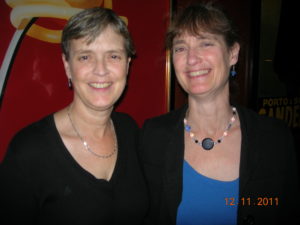
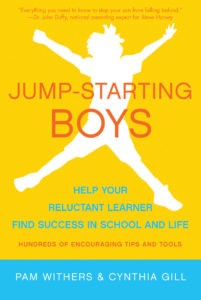
Crystal: Yeah. There are a lot of in-built roles that come with being siblings, for sure. I’d say if you can successfully co-write a project with a family member and still be on speaking terms at the end…
Pam Withers: We both had qualms about what it would do to our relationship, but in fact, it brought us closer.
Crystal: And so for that one, what did the co-authoring process look like? Was it different from the way you co-authored the fiction?
Pam Withers: She did more writing than Arooj did. She also outlined chapters that I would write. It depended on the chapter. If the chapter was something that I had pulled together, fine, but if it was something that tapped her particular expertise, she would be much more involved in it. But again, the same way as with Arooj, I would interview her, I would do some writing. She would rewrite it. Then she would do some writing. I would rewrite that. So it went back and forth a lot.
Crystal: So a pretty fluid process. And what did you find in terms of the benefits of doing it that way? What are some of the things you really enjoyed about the process in either of those cases?
Pam Withers: In both cases I felt freer. I felt a big load off my back. Because I didn’t have this fear, especially with The Parkour Club, about offending anyone or not getting it right or, you know, getting something wrong about Islam. I was freer because I had not just backup help, but a co-author. So I didn’t hold back as much. I felt less restrained. And I learned a lot. It widened my horizon. I learned more about co-authoring with Arooj. I felt like my characters were more authentic. There is such a thing as sensitivity readers, but they are really not nearly as involved as a co-author. A sensitivity reader just reads it after you’ve written it and tells you if you might’ve stepped on some toes in terms of cultural appropriation and such. With Arooj, it was much more proactive and a partnership.
Crystal: Yeah, it’s a really nice way to do it as a creator as well — then it’s not just making changes later, but really integrating that reality, that person into the character, if they’re willing. That’s a really cool way to do it.
Pam Withers: I mean, how would I know what kind of comments kids would make about a hijab, whereas she knew that all too well, and remembered it all too well. I want to give you one other example — the difference we had over how we approached the word ‘jihad.’ That word, just like the word ‘gay,’ has been co-opted by the Western media [from its original meaning] and Arooj didn’t want me to use it in the way most Westerners understand it, associated with terrorism and radicalization. So there’s a paragraph (Bronte’s train of thought) that reads:
“I know that mujahideen means people involved in jihad, which can but doesn’t always mean fighting, because jihad also refers to an internal struggle to perform acts of obedience for Allah. And hijrah refers, more or less, to Islam’s golden age—the eighth to thirteenth centuries—which some radicals think is due to be reinstated.”
That’s one paragraph that takes a whole bunch of controversial stuff and boils it down for a teenager reading an adventure book. That’s the type of thing that I could do with Arooj’s help that I never could have done otherwise. And she was very strong about making clear what jihad really means, a goal — not like we’ve warped the word it into.
Crystal: I think that’s an interesting topic. With everything that’s going in the world right now in terms of broadening our writing world and understanding diversity and making connections with people from different cultures to make sure that we really do have a varied representation that represents it’s our real life, getting it right has never been more important. And also I think being brave enough to get it wrong while we’re learning. You mentioned you had to be brave to step outside and ask for help, and to make that approach and look for somebody who was willing to partner, and I think that’s a really important message for all the writers out there: There are people everywhere who are looking to make those connections and help us understand how things really work, and the ways we have gotten things wrong in the past. So in asking, we really open up a lot of doors.
I think that’s a really important thing, just to highlight that we aren’t going to get it all right but that doesn’t mean we don’t try. And so, taking those first steps and really learning together is really, really important. Were there any challenges you came across in the co-writing (besides those two different situations that you had to get clever about overcoming)?
Pam Withers: My biggest challenge was Arooj getting pregnant and doing a PhD and running a small business, all while helping me write this book! I mean, she was just doing everything at once. So getting hold of her when I really needed to get hold of her was sometimes a challenge. I had to kind of just grit my teeth and wait for her!
Sometimes when you’re ‘in the zone’ on the writing, and you really, really need your partner to be there that moment, you just have to be more flexible than usual. So that was the biggest thing: her busy schedule. And then, you know, the little things like about the word jihad. I said, “But this is how people understand it.” She said, “No, you can’t use it like that.” I said, “Well, what if I define it — you know, within a paragraph — and then kind of use it like that?” And she said, “Okay.” So we had to compromise, we had to talk, we had to negotiate, but we got it there.
Crystal: So communication is basically the solution to all things — communication, and scheduling. And I think that is something to highlight for people as well. If you’re out there thinking about collaborating with someone, just knowing how your schedules and agendas and your priorities mesh is really important.
If you have a deadline or if you are really set on a specific routine, then the way you choose to collaborate might be impacted by that. So there are a couple of examples of folks who have worked together in completely different time zones on opposite sides of the world, which works really well because one of them would write a chapter and then the person would wake up in their morning and read it and write something and then the next person would be waking up. So you can really make some fast progress. But if it is a consultation-in-every-stage kind of thing, then you do want to be aware of what you’re both committing to and how that’s going to work.
Do you have any other pro tips to offer folks who are thinking about co-authoring — something of what you’ve learned that might help them?
Pam Withers: I think that you might want to work together a bit before you decide to formally be co-authors, because it’s so important to get somebody that you click with, and somebody who’s going to be okay with the back-and-forth.
You don’t want someone who’s my-way-or-the-highway, and you cannot be my-way-or-the-highway yourself. I think that’s what’s most important.
Crystal: And for this latest book, you ventured into the world of indie publishing. Was that your first foray into these waters?
Pam Withers: Actually, it was my second. Out of my 21 books, I have self-published two. One of them was Paintball Island. I had to self-publish it because my publisher didn’t like it. 🙂
Crystal: Oh.
Pam Withers: But, you know, in fairness it was one of my weaker creations. I did do a lot of rewriting before I self-published it. I’d like to think that maybe the publisher wishes I had done that the first round and then it wouldn’t have gotten rejected. The Parkour Club was simply too edgy to be published traditionally. I guess it’s just too edgy to want to bridge cross-cultural divides. 🙂 You certainly can get into sticky territory when you’re talking about Islam and jihad and whatever, but again, I hope it does so well that anybody who turned it down feels badly that they turned it down. 🙂 That’s my goal.
I think if you need to self-publish, then self-publish. I’ve published 21 books, so I already have an audience out there to piggyback on, and that helps; you’ve already got a name, so it’s going to do better for publicity than if you were doing it as a number one.
Crystal: As far as the new publishing venture you’ve had, is there anything you learned along the way that was surprising, or that you hadn’t had to tackle so much in the traditional publishing world?
Pam Withers: Absolutely everything! It was complete Greek to me, and when I first started looking into self-publishing, I found sums quoted between $4,000 and $7,000 to do the whole package deal. I didn’t have that kind of money, and I wasn’t about to spend that. So I managed to find an outfit called The Creative Academy (you!), and I absolutely would not have gotten through self-publishing without that helping hand and knowledge, and it kept the costs way down below other places. It was a minuscule cost compared with those $7,000 packages.
Just so listeners know, Crystal here is not paying me to do this, but absolutely, she is your person for being walked through the indie process. It’s not for the faint of heart and it’s not for someone who doesn’t know how to do it.
Crystal: Yeah, I think that’s where The Creative Academy came from, and where a lot of our writers’ groups really come from. We’re trying to make sure that people know that there are options and different ways to do it.
You can have a very professional product without paying the equivalent to the down payment on a car, for that experience. So, definitely check the resources we’ve collected up as much as we can, to help make sure that everybody has all the options they could imagine. And if people are interested in connecting with you or learning more about your books, where can they find you?
Pam Withers: www.pamwithers.com. Everything is there. I also have book trailers for all my books. I have a couple of readings on video, and I’m very pleased that Arooj did a reading from the book. So, Arooj and I continue to stay in touch and have fun. I actually just made a quilt for her baby.
Crystal: Lovely. And we’ve got a couple more minutes, so I’m curious to talk a little bit about book trailers, because that is something that people are also interested in. Where did you get those made? What was your approach to that?
Pam Withers: The first one I had professionally made by Craig McNichol, who is writer Sylvia McNichol’s son. But I didn’t want to pay that out for every book trailer. So I started taking some courses online, and basically settled on Spark Adobe. Spark Adobe kind of walks you through it. It’s maybe a little restricted for people who want to do really fancy things, but it’s really easy to understand for people who are doing a first-time simple book trailer. So it was a series of slides with music and a little bit of plot, to get people wanting to read the book.
I’ve done all my book trailers with Spark Adobe, using free pictures from Unsplash.com, but in some cases also buying pictures from photo stock sites, or video. So, for instance, my Stowaway trailer is probably my best one because that was done professionally. But the other thing is you can do a sort-of book trailer and then hand it to Craig and he pretties it up and makes it professional. He has been a great help to me.
Crystal: That’s a nice option, kind of compiling the bones of a thing, a bit like your research notes or a rough draft, and then having it polished up — is a great way to compromise it in the middle there. Yeah. Nice. Well, we will put links to all the resources that have mentioned, and links to Pam’s books and also some of her trailers.
So you can check out all the good stuff there in the show notes. So be sure to check that out. And we will look forward to hearing all about your next book.
Pam Withers: Thank you, Crystal.

